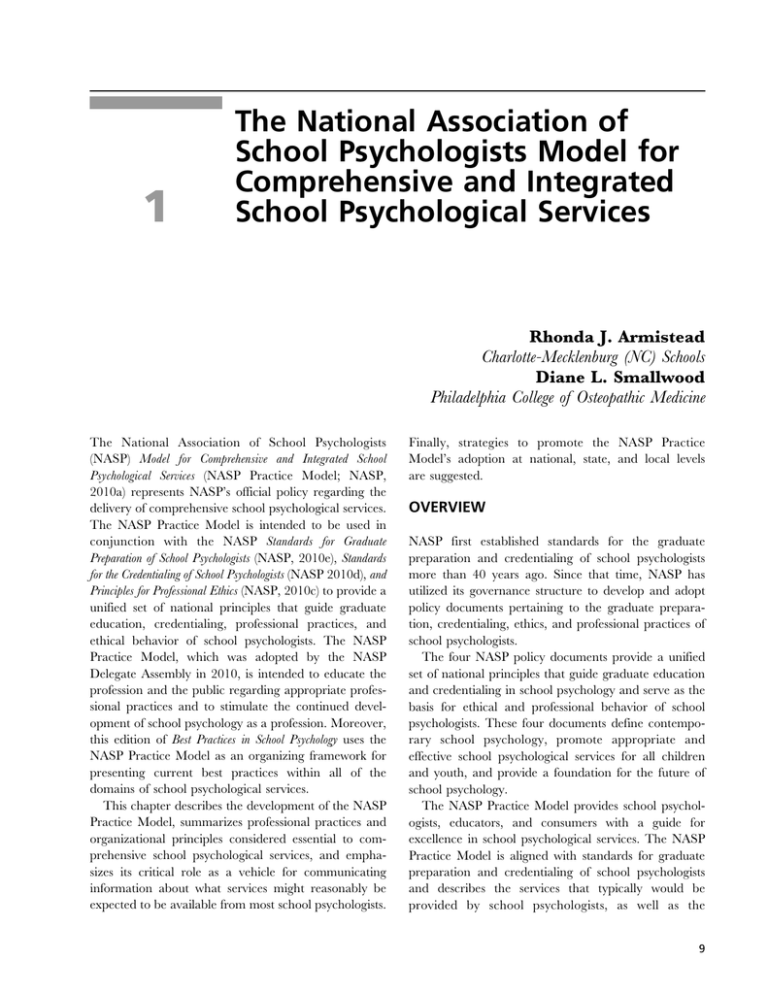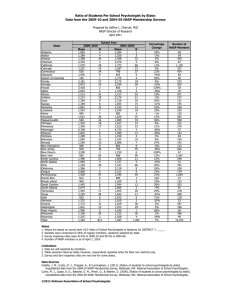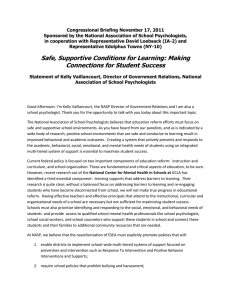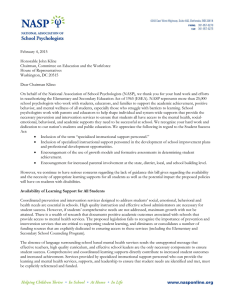1
advertisement

1 The National Association of School Psychologists Model for Comprehensive and Integrated School Psychological Services Rhonda J. Armistead Charlotte-Mecklenburg (NC) Schools Diane L. Smallwood Philadelphia College of Osteopathic Medicine The National Association of School Psychologists (NASP) Model for Comprehensive and Integrated School Psychological Services (NASP Practice Model; NASP, 2010a) represents NASP’s official policy regarding the delivery of comprehensive school psychological services. The NASP Practice Model is intended to be used in conjunction with the NASP Standards for Graduate Preparation of School Psychologists (NASP, 2010e), Standards for the Credentialing of School Psychologists (NASP 2010d), and Principles for Professional Ethics (NASP, 2010c) to provide a unified set of national principles that guide graduate education, credentialing, professional practices, and ethical behavior of school psychologists. The NASP Practice Model, which was adopted by the NASP Delegate Assembly in 2010, is intended to educate the profession and the public regarding appropriate professional practices and to stimulate the continued development of school psychology as a profession. Moreover, this edition of Best Practices in School Psychology uses the NASP Practice Model as an organizing framework for presenting current best practices within all of the domains of school psychological services. This chapter describes the development of the NASP Practice Model, summarizes professional practices and organizational principles considered essential to comprehensive school psychological services, and emphasizes its critical role as a vehicle for communicating information about what services might reasonably be expected to be available from most school psychologists. Finally, strategies to promote the NASP Practice Model’s adoption at national, state, and local levels are suggested. OVERVIEW NASP first established standards for the graduate preparation and credentialing of school psychologists more than 40 years ago. Since that time, NASP has utilized its governance structure to develop and adopt policy documents pertaining to the graduate preparation, credentialing, ethics, and professional practices of school psychologists. The four NASP policy documents provide a unified set of national principles that guide graduate education and credentialing in school psychology and serve as the basis for ethical and professional behavior of school psychologists. These four documents define contemporary school psychology, promote appropriate and effective school psychological services for all children and youth, and provide a foundation for the future of school psychology. The NASP Practice Model provides school psychologists, educators, and consumers with a guide for excellence in school psychological services. The NASP Practice Model is aligned with standards for graduate preparation and credentialing of school psychologists and describes the services that typically would be provided by school psychologists, as well as the 9 Best Practices in School Psychology organizational conditions needed to support the delivery of effective school psychological services. Although there is no question that there is substantial variability among school psychologists with regard to levels of training, years of experience, and specific professional competencies, graduate education programs that are consistent with national standards prepare school psychologists to have at least entry-level skills in each of the domains described by the NASP Practice Model. As an introduction to this edition of Best Practices, this chapter will describe the significance of the NASP Practice Model and the rationale and processes used to inform its development. The chapter will place the NASP Practice Model within the context of educational reform and summarize empirical support for the domains and the organizational principles relative to improving the outcomes for schools, families, and students. Suggested practices for the NASP Practice Model’s use by school psychologists, supervisors, graduate education programs, and state associations will be described. BASIC CONSIDERATIONS The 2000 revision of the standards documents marked the initiation of a 10-year review and revision cycle for NASP standards. Prior to that time, the four standards documents were developed and revised as individual policy statements that addressed critical aspects of the school psychology profession. Beginning in 2000, however, the standards documents were reviewed and revised as an integrated set of principles that are interrelated and united in their purpose of advancing consistency in graduate preparation, credentialing, ethics, and professional practices in school psychology. The 2010 NASP Practice Model is the most recent revision of the Standards for the Provision of School Psychological Services, which was first adopted by NASP in 1978, with later revisions in 1984, 1992, 1997, and 2000. Throughout all of the updates, the purpose of the document has been to define excellence in the practice of school psychology and to educate both professionals and consumers regarding appropriate professional practices. In 2000, the title of the Standards for the Provision of School Psychological Services was changed to the Guidelines for the Provision of School Psychological Services (NASP, 2000a) to reflect the differences in the enforceability of standards in graduate preparation and credentialing versus in practice settings. The NASP program approval process and the National School Psychology Certification Board provide vehicles for requiring standards in graduate programs 10 and credentialing, at least for NASP-approved school psychology graduate programs and for school psychologists holding the Nationally Certified School Psychologist (NCSP) credential. Because there is no comparable mechanism for enforcing standards for professional practice, it was thought more appropriate to view the practice document as a set of guidelines that define best practices for the profession rather than as enforceable standards. NASP has created a national model for the practice of school psychology with its 2010 NASP Practice Model. The NASP Practice Model is closely aligned with the standards for graduate preparation and credentialing, and it translates the knowledge and skills required of school psychologists into statements of what school psychologists routinely do to address the diverse needs of children, families, and schools. Visions of the Future in School Psychology School Psychology: A Blueprint for Training and Practice is a series of documents first published in 1984 and revised in 1997 and 2006 (Ysseldyke, Reynolds, & Weinberg, 1984; Ysseldyke et al., 1997; Ysseldyke et al., 2006). These works, authored by a small but influential group of school psychologists, attempted to build upon the collective foundations of knowledge discussed via the professional ‘‘futures’’ conferences dating from Boulder in 1949 through the 2002 online conference on the Future of School Psychology. Blueprints I, II, and III have had significant impact on NASP standards, particularly the official NASP Standards for Graduate Preparation of School Psychologists. The Blueprint series were visionary documents designed to reflect ‘‘exemplars of successes and promising trends in today’s schools and the school psychology specialty’’ as a means of forecasting the training and practice needs of school psychologists (Ysseldyke et al., 2006, p. 39). By examining circumstances within education and emerging factors in society, Blueprint framers were able to propose changes and correct limitations of previous versions. The Blueprint envisioned that in order for school psychologists to be instrumental in improving the academic and social–emotional outcomes of children, domains of competencies were needed. The Blueprint also recognizes that school psychologists must be involved in helping systems build and sustain their capacity for fostering and developing the essential academic and social competencies for students. School psychologists, as systems consultants, were meant to ensure that the individual components of systems would National Association of School Psychologists


